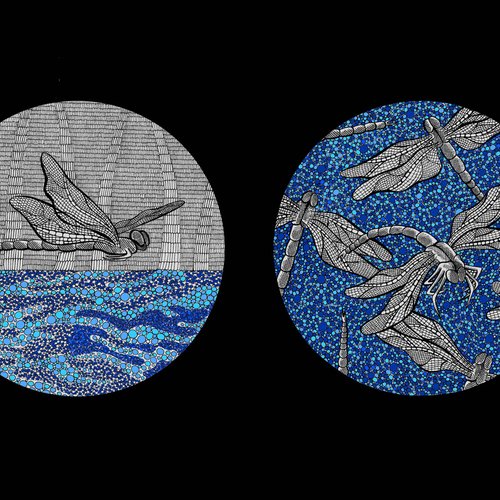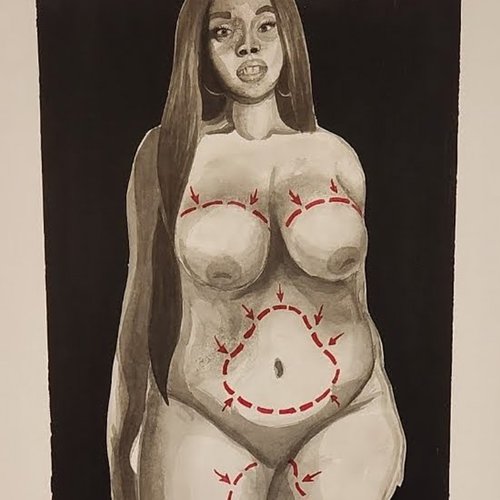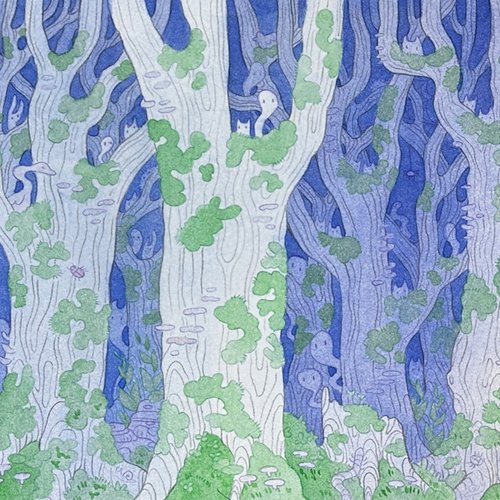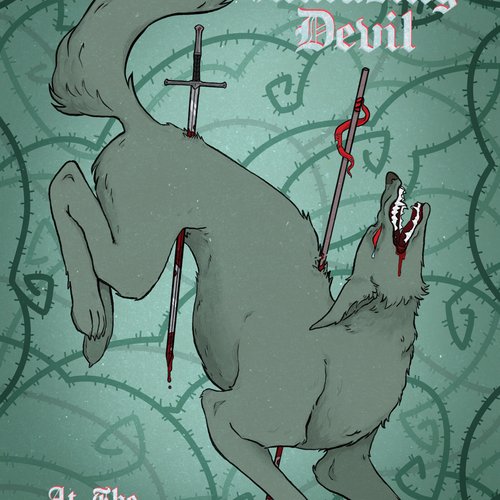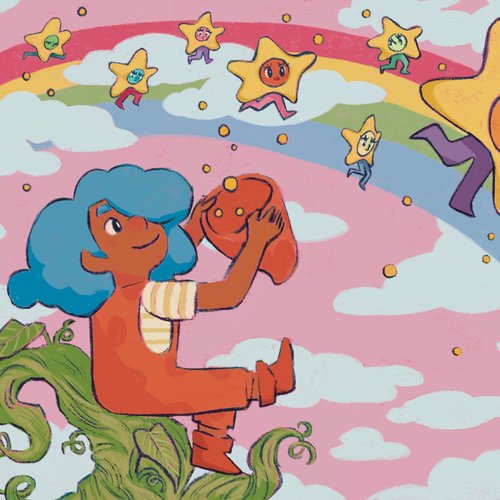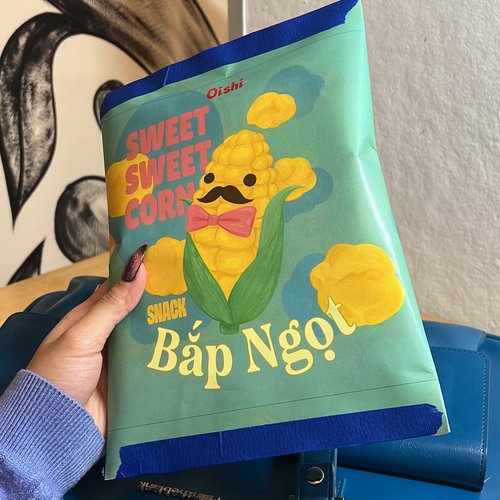Inside the studio with graduating BFA Illustration seniors
This semester 10 senior illustrators get ready for the culminating moment of their CCA experience and launch their careers in the senior thesis exhibition.
An earnest buzz thrums through CCA’s Illustration program senior studios at midterm with six weeks to go until the senior show. Students are bent over boards of fine watercolor papers mixing paint to apply color in systematic layers. They are working on iPads “painting” in pixels of every imaginable color. They are breaking the bonds of 2D space to manifest their ideas into children’s books, sculptural objects, printed textiles, clay characters and bedazzled canvases. The visual languages emerging from all this activity are as diverse as each individual artist at work there.

Ollie Davis presents their sketches of animals in the midterm critique in Shannon Taylor’s thesis studio class. Photo by Mara Holt Skov.
“How do you distill down the last four years into an 8 x 8–foot space?” Illustration Chair Michael Wertz empathizes with the challenge that each senior in the program faces as they envision and produce the ten thematically unified pieces that constitute a senior’s thesis exhibition. But, design is about limitations. Even though illustrators are the ‘artists’ of CCA’s Design division, they are used to working within constraints and with context and an audience always in mind.
Says Wertz, “The end of semester exhibition is such a wonderful chance to see where these students’ work is radically different, but at the same time many of their concerns are the same.” The similarities include facility with their chosen media and a strong interest in storytelling. The Illustration curriculum offers students many opportunities to hone both of these skills. They also have the freedom to try out a wide variety of mediums across CCA. Painting and drawing, sculpture, graphic design, animation, ceramics, printmaking, and others—illustrators play nice with so many other disciplines.
Students explore wide-ranging themes and media
The senior thesis project gives students the opportunity to identify their own themes and ideas, free from the constraints of an assignment directed by faculty. They learn to identify a topic of interest and the media and methods to probe that topic more deeply. Through their thesis project, in tandem with a portfolio development class, they create a personal body of work that expresses their visual language and ability to use a variety of traditional and digital media techniques. This work also represents a moment of self-reflection and a chance to present their work to the public with an eye to where it might resonate out there in the world.
Though each student’s work looks vastly different due to their methods of representation and distinct visual languages, many thesis projects explore themes that artists have been concerned with for as long as humans have been making art. Bubbling up through this year’s senior work are timeless topics such as the human connection to nature, the sacred and the spiritual, fantastical worlds and creatures, personal identity and expressions of the beauty we see all around us.

Erika Wahlberg presents her ideas for a choose-your-own-adventure book in the midterm critique in Shannon Taylor’s thesis studio. Photo by Mara Holt Skov.
Three seniors are creating magical creatures and stories that play out in imaginary settings. Erika Wahlberg populates her “little corner of sunshine and rainbows” with blue-haired gnomes, mushroom houses, cheerful stars and friendly flowers in a book where the reader gets to choose their own adventure. Ollie Davis bids a “graceful goodbye to my undergraduate years” in a series of imagined and “delightfully weird” animals inspired by the delicious creepiness of Grimms’ Fairy Tales and the Spiderwick Chronicles. And Jaia Linden-Engel’s vibrant watercolor forests provide a backdrop for the story of a dragon and a little girl whose friendship helps each of them overcome their fears—the dragon’s fear of the artificial lights in the little girl’s home, and the girl’s fear of the dragon’s dense forest habitat.
Shay Beckson and Andrianna Scott are both working on questions of femininity but through different lenses. Shay through her digital self-portrait paintings reveals how femininity connects directly to nature through everyday rituals practiced within sparkling and verdant landscapes and Andrianna by highlighting the challenges associated with living in a female body and the tension between bodily realities and societal expectations.

In the Illustration studio, Viv Pham and Jaia Linden-Engel work in watercolor on their senior projects. Photo by Mara Holt Skov.
Memory is the catalyst for two senior thesis projects that are taking very different aesthetic directions. Viv Pham’s playful installation pays homage to her childhood home growing up in Vietnam with her grandparents, including the snacks and drinks she loved as a young girl, while Kiersten Yorks’s series of pen-and-ink drawings are based on preliminary research and personal interviews to enable her to visualize the experiences of people who have used ritual or recreational psychedelics. Listening to the taped interviews immerses her in the story as she inks each individual drawing adding layers of digital color later.
Senior illustrators have embraced the flexibility (and responsibility) of the thesis project’s open parameters to further develop their approach to media techniques, format, and personal expression. Passion projects such as Felix Orozco-Mendoza’s acrylic paintings celebrate the body and the ways we embellish ourselves, offering a correction to the lack of queer representation that they felt in their community growing up. And in an entirely different media and approach, Yiyang (Vito) Deng’s wide-screen formats, suitable for film and gaming, are created using digital painting tools (Blender for modeling and ZBrush for sculpting) to generate sweeping cinematic landscapes and urban scenes that hold in dynamic tension equal moments of stillness and dramatic action.

Marianne Wilson uses digital and analog methods to create characters based on her real friends. Photo by Mara Holt Skov.
Many seniors just want to have some fun before they graduate. Marianne Wilson looks forward to a celebration drink with friends by creating playful paper doll likenesses of her real friends in their favorite outfits, moving skillfully from analog to digital sketches and refinement. “I’m so inspired by real life people that I don’t need to make characters up,” she says.
Though the work of these 10 graduating seniors is evolving, each one has a clear vision for what it will become by the time it is introduced to the public in the senior show on Friday, December 8, 2023 from 5–8 pm in the Nave of CCA.
Challenges and opportunities for illustrators today
Program chair and former CCA Illustration student himself Michael Wertz has seen students with their degrees in hand head off in many directions. There is a wide spectrum of opportunity for illustrators, from publishing to periodicals to other forms of print work. There are comics, packaging, surface design, visual development, and apparel to name just a few of the additional possibilities.
Illustration senior thesis professor Robert Hunt, who after 40 years as an illustrator has seen vast changes in the field, believes that this group of emerging professionals has come through the pandemic and found resilience along the way. He notes, “They have a strong work ethic. This is a truly exceptional class.” They have found ways to channel their anxieties and create work that represents their experience in the world and demonstrates their values in visual terms. Illustration may often be about personal expression and representation, but it is also about starting conversations with others.
In response to rumbling fears about the challenge of artificial intelligence, Hunt says, “If you want to look at AI as a threat, you can see it as a threat” reminding us that each new technology makes us feel insecure until we adapt to it. “There will be consequences, but not the ones that we expect.” Hunt feels hopeful for this group of students because they have new avenues to get their voices out in the world, avenues that were never before possible. But he cautions that it will take flexibility, a certain amount of business sense, the agency to deliver what you say you will, and curiosity for what is beyond the horizon. There are also nascent areas of opportunity in sectors and in jobs that have yet to be defined.
The illustrator’s mission
Chair Michael Wertz notes that in our Illustration program, faculty and alumni provide ample responses to the continuing question every CCA student wonders as they near graduation: “How do I want to live as a creative person in the world?” Not everyone will become a traditional illustrator. Still, wherever each graduating senior lands, their creativity, knowledge, and self-expression has set them up to do meaningful work. What they take away from CCA’s illustration program are creative approaches to challenging problems no matter the “industry” they may find themselves in or the story they are called to tell.
Graduating senior Felix Orozco-Mendoza takes another approach to his mission as an artist illustrator, “My work might not transform the world, but it sure as hell makes living in this world better!”

Felix Orozco-Mendoza presents their senior thesis work during a midterm critique in Illustration professor Shannon Taylor’s thesis studio.
—Mara Holt Skov, associate professor, Industrial Design
December 5, 2023

